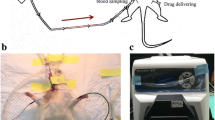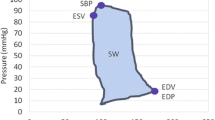Abstract
Extracorporeal circulation (ECC) is indispensable for cardiac surgery. Despite the fact that ECCcauses damage to blood components and is non-physiologic, its pathophysiology has not been fully elucidated. This is because difficulty in clinical research and animal experiments keeps the knowledge insufficient. Therefore, it is desirable to have a miniature ECC model for small animals, which enables repetitive experiments, to study the mechanism of pathophysiological changes during ECC. We developed a miniature ECC system and applied it to the rat. We measured changes in hemodynamics, blood gases and hemoglobin (Hb) concentration, serum cytokines (TNF-α, IL-6, IL-10), biochemical markers (LDH, AST, ALT), and the wet-to-dry weight (W/D) ratio of the lung for assessing whether the rat ECC model is comparable to the human ECC. The ECC system consisted of a membranous oxygenator (polypropylene, 0.03 m2), tubing line (polyvinyl chloride), and roller pump. Priming volume of this system is only 8 ml. Rats (400–450 g) were divided into the SHAM group (n = 7) and the ECC group (n = 7). Blood samples were collected before, 60 and 120 min after initiation of ECC. During ECC, blood pressure and Hb were maintained around 80 mmHg and 10 g/dL, respectively. The levels of the inflammatory and biochemical markers and the W/D ratio were significantly elevated in the ECC group, indicating some organ damages and systemic inflammatory responses during ECC. We successfully established the ECC for the rat. This miniature ECC model could be a useful approach for studying the mechanism of pathophysiology during ECC and basic assessment of the ECC devices.



Similar content being viewed by others
References
Walker G, Liddell M, Davis C. Extracorporeal life support-state of the art. Paediatr Respir Rev. 2003;4:147–52.
Gao D, Grunwald GK, Rumsfeld JS, Mackenzie T, Grover FL, Perlin JB, McDonald GO, Shroyer AL. Variation in mortality risk factors with time after coronary artery bypass graft operation. Ann Thorac Surg. 2003;75:74–81.
Pasquale MD, Cipolle MD, Monaco J, Simon N. Early inflammatory response correlates with the severity of injury. Crit Care Med. 1996;24:1238–42.
Jiang Hongchi, Meng Fanqiang, Li Wei, Tong Liquan, Qiao Haiquan, Sun Xueying. Splenectomy ameliorates acute multiple organ damage induced by liver warm ischemia reperfusion in rats. Surgery. 2007;141:32–40.
Developed by the Task Force on Blood Component Therapy. Practice guidelines for blood component therapy: a report by the American Society of Anesthesiologists Task Force on blood component therapy. Anesthesiology. 1996;84:732–47.
de Gast-Bakker DH, de Wilde RB, Hazekamp MG, Sojak V, Zwaginga JJ, Wolterbeek R, de Jonge E, Gesink-van der Veer BJ. Safety and effects of two red blood cell transfusion strategies in pediatric cardiac surgery patients: a randomized controlled trial. Intensiv Care Med. 2013;39:2011–9.
Fujii Y, Shirai M, Inamori S, Shimouchi A, Sonobe T, Tsuchimochi H, Pearson JT, Takewa Y, Tatsumi E, Taenaka Y. Insufflation of hydrogen gas restrains the inflammatory response of cardiopulmonary bypass in a rat model. Artif Organs. 2013;37:136–41.
Fujii Y, Shirai M, Tsuchimochi H, Pearson JT, Takewa Y, Tatsumi E, Taenaka Y. Hyperoxic condition promotes an inflammatory response during cardiopulmonary bypass in a rat model. Artif Organs. 2013;37:1034–40.
Aebert H, Kirchner S, Keyser A, Birnbaum DE, Holler E, Andreesen R, Eissner G. Endothelial apoptosis is induced by serum of patients after cardiopulmonary bypass. Eur J Cardiothorac Surg. 2000;18:589–93.
Boyle EM, Pohlman TH, Johnson MC, Verrier ED. Endothelial cell injury in cardiovascular surgery: the systemic inflammatory response. Ann Thorac Surg. 1997;63:277–84.
Butler J, Rocker GM, Westaby S. Inflammatory response to cardiopulmonary bypass. Ann Thorac Surg. 1993;55:552–9.
Engelman RM, Rousou JA, Flack JE 3rd, Deaton DW, Kalfin R, Das DK. Influence of steroids on complement and cytokine generation after cardiopulmonary bypass. Ann Thorac Surg. 1995;60:801–4.
Cremer J, Martin M, Redl H, Bahrami S, Abraham C, Graeter T, Haverich A, Schlag G, Borst HG. Systemic inflammatory response syndrome after cardiac operations. Ann Thorac Surg. 1996;61:1714–20.
Conflict of interest
The authors have no conflict of interest directly relevant to the content of this article.
Author information
Authors and Affiliations
Corresponding author
Rights and permissions
About this article
Cite this article
Fujii, Y., Shirai, M., Inamori, S. et al. A novel small animal extracorporeal circulation model for studying pathophysiology of cardiopulmonary bypass. J Artif Organs 18, 35–39 (2015). https://doi.org/10.1007/s10047-014-0804-y
Received:
Accepted:
Published:
Issue Date:
DOI: https://doi.org/10.1007/s10047-014-0804-y




